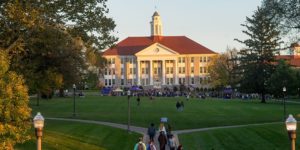If one more person says to me, “So, enjoying your summer off?,” I’m gonna scream. True, the number of classes in session is fewer, the number of students on campus has dropped, and the number of meetings has dwindled. Yet June and July are busy months for those of us who oversee general education programs at public universities.
 Our unit, University Programs, manages the enrollment of all first year students–at present, we expect more than 4,600 freshmen and about 650 transfers (we use the term Firstyears for both populations). That many bodies requires a lot of seats! In the past, we assumed an average of 4.2 general education classes per freshman to make a full-time schedule of 12-15 credits. Today, I use 4 general education courses per freshman because more of them also need intro courses in the major. Still, in round numbers, that’s about 18,500 seats distributed across hundreds of sections of the general education program’s 80-some courses. My office works closely with departments and the Registrar to hold back (well, okay, hide) these seats from continuing sophomores, juniors, and seniors. Holding back seats helps to ensure that freshmen can make appropriate schedules when their enrollment period begins in June.
Our unit, University Programs, manages the enrollment of all first year students–at present, we expect more than 4,600 freshmen and about 650 transfers (we use the term Firstyears for both populations). That many bodies requires a lot of seats! In the past, we assumed an average of 4.2 general education classes per freshman to make a full-time schedule of 12-15 credits. Today, I use 4 general education courses per freshman because more of them also need intro courses in the major. Still, in round numbers, that’s about 18,500 seats distributed across hundreds of sections of the general education program’s 80-some courses. My office works closely with departments and the Registrar to hold back (well, okay, hide) these seats from continuing sophomores, juniors, and seniors. Holding back seats helps to ensure that freshmen can make appropriate schedules when their enrollment period begins in June.

Advising session during Springboard. High school transcripts, dual enrollment transcripts, and AP scores are still arriving at this point in the summer.
It’s my job to keep track of how many seats are available in general education courses, and to do it I monitor JMU’s systems regularly. Incoming freshmen register online using a series of web-based how-to videos, worksheets developed by University Programs, and advisor input. No other students have access at this time. During the 13 days of Summer Springboard, they come to campus as part of JMU’s orientation program, meet their advisors face to face, and make any adjustments to their schedule. The wrinkle is that students are bringing more transfer credit from high school dual enrollment courses and AP exams—and there’s no perfect way to know which program requirements they have met with these credits until their transcripts get here. Someday soon I’ll write a post about the perils and promises of transfer credit, but suffice it to say here that this information directly affects the number of sections and seats in certain courses offered each fall.
Summer isn’t just about seats, though. Orientation affords an opportunity to talk directly to students and their parents about the value of a liberal arts and sciences education. JMU’s outcomes-based liberal education program, General Education: The Human Community is 20 years old now; we were one of the first institutions in the nation to abandon the old distributive approach in favor of a coherent curriculum. We are a national leader in assessment practices, and we have won recognition from the AAC&U, CHEA and AGLS. The program has dedicated faculty, administrative support, and an ample budget. And yet even we feel the need to advocate constantly for its distinctive and essential role in every bachelor’s degree.
When I address the class of 2022 and their families during Springboard, I know that, notwithstanding their excitement, many in the audience are worrying about rising tuition and student debt loads. Though the economy is improving, it’s still tough to get a job in Virginia, even with a degree. The anxiety is palpable, and for me it explains not only the dramatic shifts in the majors students now declare, but their recent embrace of dual enrollment. And while I understand these choices, I worry that they are misguided.
My approach is to herald the good news proclaimed by numerous recent reports–that every part of a bachelor’s degree has value, and further, that a coherent general education program provides the best long term preparation for success. The statistics help: from 2007-2012, 82% of all new jobs created in the USA required a bachelor’s degree; by age 39, the average American with a bachelor’s degree will hold 10-14 different jobs across multiple fields; within five years of graduation, only 50% of degree-holders will still be employed in the field in which they majored. The most powerful bit of my remarks comes with an activity. First, I ask college-educated parents who still work in their baccalaureate majors to raise their hands, then I ask college-educated parents who have changed careers to raise their hands. The second group is always much larger, and it’s a potent illustration of what the numbers mean for actual people.
Summer may seem like an unlikely time to talk about post-graduation realities. For freshmen, it’s a good time because it marks a milestone in their transition to independent adulthood. Having just graduated from high school, they look toward the fall with anticipation yet they know that college lasts a mere four years. They expect to graduate and they choose majors, most of them, anyway, with the near future in mind. So they are already thinking about the journey ahead, they just don’t have a detailed map.
My hope is that they will view the general education program as essential to their preparation for life. Instead of a random collection of courses grouped by disciplinary categories, we offer a limited array of choices in areas defined by shared learning outcomes. That is by design. Just as faculty here created curricula for majors based on each field’s specific standards, so they created a core curriculum of general education courses to provide what every student needs to know, do, and understand.
Summer isn’t the only time to make the case for liberal education. We message in a variety of other ways, at myriad points in the academic year, and many program faculty add their voices to the chorus. And there is some evidence that it’s working, at least for some students. A recent set of focus groups with undergraduates, for example, reveals their awareness of the way the program complements their majors. The irony is that, by the time they get it, they are ready to leave.
And so it goes. With each summer comes a new class of freshmen. There’s never a summer off.

